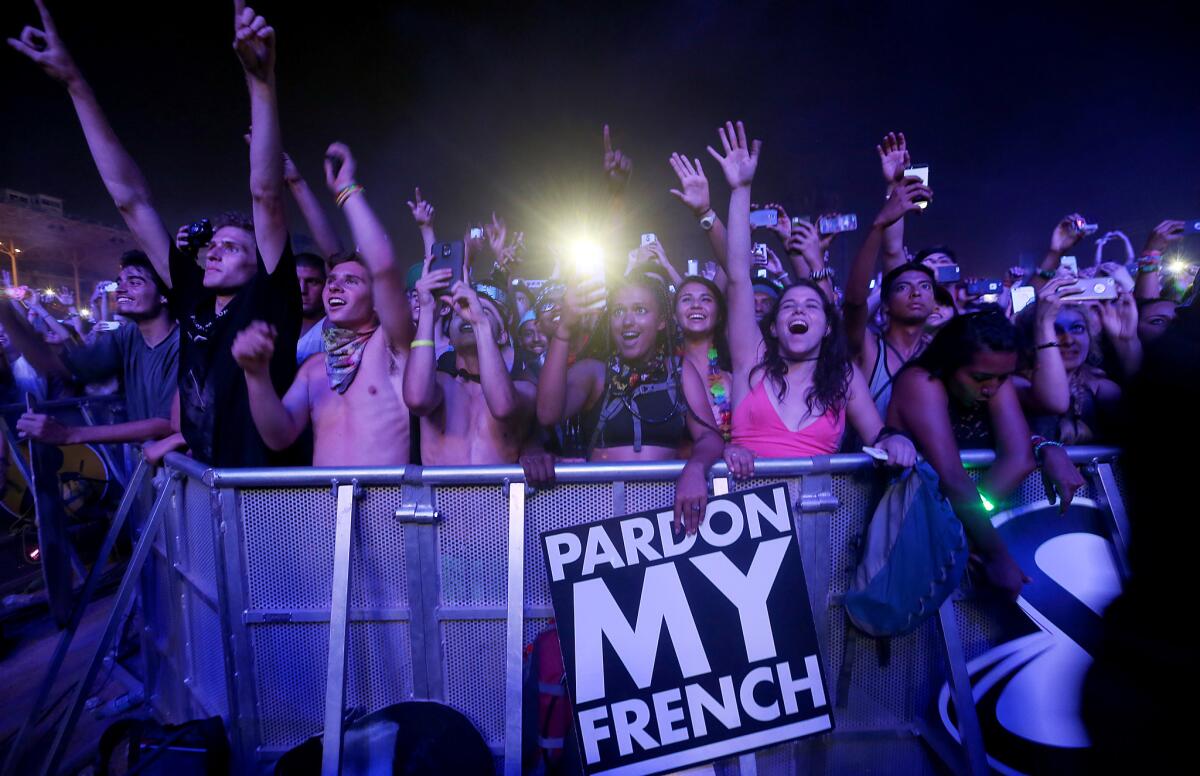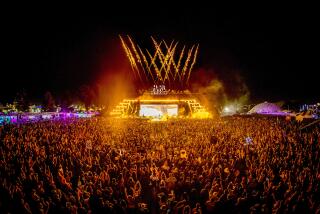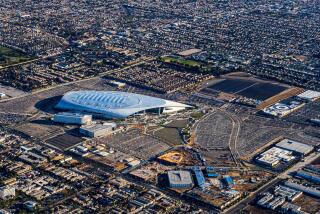What last weekend’s rave looked like to ER doctors

Fans watch a performance by Porter Robinson during Hard Summer at the Fairplex in Pomona on Saturday.
The pace is rarely slow at Pomona Valley Hospital Medical Center during weekends.
But it was heart-poundingly faster when Live Nation Entertainment’s Hard Summer music festival came into town, with ambulances sending overdosing concertgoers from the Los Angeles County fairgrounds.
Dr. Bradford Hardesty saw one man so combative that he had to be sedated to keep him safe, as well as the nurses and doctors. His heart rate was up to more than 200 beats per minute — double the normal rate.
“It had taken multiple police officers to hold him down. It took almost five or six staff members here,” Hardesty said.
What happened at last weekend’s rave is generating debate about whether more can be done to keep those who attend safe. Two young women died of suspected drug overdoses, and dozens of others required attention in the emergency room.
The rave was held on land mostly owned by L.A. County. County supervisors are now considering a temporary ban on raves on county property until an investigation into what happened is complete.
Quite a few ravegoers came in with drug-induced seizures, Hardesty said. Some couldn’t answer questions because they were so drugged. Some extremely aggressive patients had to be placed under constant care and under heavy sedation, he said.
Ravegoers with high temperatures “get so agitated and confused that they can’t be controlled,” said Dr. Kenneth Nakamoto, an emergency room physician at Pomona Valley Hospital Medical Center. “And we ended up having to admit several to the intensive care unit.”
The dramatic scene in the emergency room, however, was not a surprise.
Officials spent months planning for the event, which brought in about 122,000 people over two days to the Los Angeles County fairgrounds.
The Pomona Valley hospital increased staffing. Beverly Hills-based Live Nation Entertainment said it set up two primary medical tents at the Fairplex, paid for three emergency room doctors, 13 registered nurses and 63 emergency medical technicians, and even deployed drug-sniffing dogs.
Despite those efforts, 49 people were taken by ambulance to seven emergency rooms across the region, according to the county and the Pomona Valley hospital. One person was taken 28 miles away, to Pasadena, according to the county.
Live Nation Entertainment maintains that only 37 were transported.
That is an “unusually high number of transports,” said Richard Tadeo, assistant director for the Los Angeles County Emergency Medical Services Authority. “I think a lot of people were able to bring in drugs.”
Live Nation Entertainment, one of the world’s largest concert and ticketing conglomerates, which recorded $4.7 billion in concert revenue in 2014, said in a statement that it is “fully cooperating” with the county Board of Supervisors’ request for an investigation.
“The festival plan was designed with direct input and approval from all of the relevant county and government agencies as well as the fairgrounds’ management,” the statement said.
The Pomona Valley hospital saw 28 patients in its 50-bed emergency room, according to Laurie Sepke, a registered nurse and the hospital’s liaison with the fire department.
“You have heat, you have a lot of energy drinks, alcohol, drugs that induce euphoria but also increase temperature, and heart rate and blood pressure,” Sepke said.
“It really creates a very dangerous situation,” added Nakamoto.
Two women died on the rave’s first day from apparent overdoses. UCLA student Tracy Nguyen, 18, suffered a seizure of unknown length when paramedics responded at 4:45 p.m. on Aug. 1. She became pulseless as she was rushed to San Dimas Community Hospital, where she was declared dead, the coroner said.
At about 7 p.m., Cal State Channel Islands student Katie Dix, 19, went into respiratory and cardiac distress after witnesses saw her drinking alcohol and taking a drug orally. Doctors tried to resuscitate her for half an hour at the Pomona Valley hospital before she was declared dead, the coroner said. Autopsy results are pending.
The latest deaths prompted three emergency room directors to call for an end to large raves in Los Angeles County, citing the threat to public health.
Other venues, such as the Los Angeles Memorial Coliseum and the state-run Cow Palace near San Francisco, have stopped hosting raves. But they have continued elsewhere, often farther away from the city center, such as at the Los Angeles County fairgrounds and the San Manuel Amphitheater in Devore, which is owned by San Bernardino County and managed by Live Nation Entertainment.
“We’ve seen this all around the nation ... in L.A., it popped up in Chicago, in San Francisco, in New York,” said Dr. Marc Futernick, emergency services medical director at Dignity Health California Hospital Medical Center in downtown Los Angeles. “There’s something about these events that leads to this rampant drug abuse ... and young adults are really getting hurt and paying the price.”
During raves, there were so many overdoses that ambulances had to spread out as they do, for example, after the crash of a packed commuter train. California Hospital was one of the worst-hit hospitals, receiving 20 to 30 ambulance runs from every event, Futernick said.
“These were patients that were just really ill. Altered. Comatose. Requiring ventilatory support,” Futernick said. “Temperatures I’ve never seen with infections, only with this kind of drug abuse. Temperatures, literally, 107, 108, 109 degrees, the kind of temperatures that there’s no other way to describe it other than it will melt your organs and do damage to your organs to the point you will die.”
Dehydration can pose a problem. But so can drinking too much water, causing sodium levels to crash. That has triggered lengthy seizures that block oxygen to the brain, Futernick said.
“If the county wants to make money while people are dying and medically compromised ... they should come out and say it,” said Dr. Philip Fagan Jr., emergency department director at Good Samaritan Hospital in Los Angeles.
Other types of music festivals don’t pose as severe a problem, said Dr. Brian Johnston, chairman of the emergency medicine department at White Memorial Medical Center in Los Angeles. From raves, teens have come into his ER suffering heart attacks. “You don’t see that from other events. This is a different animal. When they were doing them in the Coliseum, they had so many casualties that they hired their own ambulances to wait. They know it’s going on.”
Raves at the Coliseum ended shortly after a 15-year-old girl died from an Ecstasy overdose after attending the Electric Daisy Carnival in 2010, which had 185,000 guests over two days. Electric Daisy was moved to Las Vegas the next year by its operator, Insomniac, which became a subsidiary of Live Nation Entertainment in 2013.
There have been at least 20 drug-related deaths among people who went to raves nationwide run by Los Angeles-area companies since 2006, according to a Los Angeles Times review of coroner records and interviews. Nine were in Southern California and five in the Las Vegas area.
Live Nation Entertainment outlined a number of precautions the company took.
Organizers hired a private security company to conduct airport-style bag checks and pat-downs of guests and set up “amnesty boxes” where attendees could surrender drugs.
The company also established 168 free water-distribution valves over seven locations, provided 10,000 bottles of free water and placed three out of five stages in air-conditioned indoor venues.
Live Nation Entertainment also paid for the presence of 23 Los Angeles County firefighters and 184 police officers and employed more than 950 people for private security.
Live Nation has been a big investor in electronic dance music festivals, and purchased L.A.-based Hard Events in 2012. In a filing with the U.S. Securities and Exchange Commission in November 2013, Live Nation said it expected to roughly double its electronic dance music attendance that year from the previous year.
Follow us on Twitter: @ronlin @lacrimes
ALSO:
Northern California cop placed on leave after pulling gun on man recording him
Dig for remains of missing person continues on La Puente property
Boy, 9, struck and killed by vehicles while walking with sister in Orange
More to Read
Sign up for Essential California
The most important California stories and recommendations in your inbox every morning.
You may occasionally receive promotional content from the Los Angeles Times.












